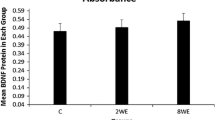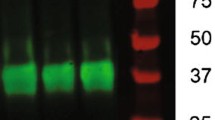Abstract
The aims of the present study were to investigate in brain of adult rats (1) whether exercise-induced activation of brain-derived neurotrophic factor (BDNF)/tropomyosin-related kinase B (TrkB) pathway is dependent on exercise intensity modality and (2) whether exercise-induced improvement of memory is proportional to this pathway activation. Wistar rats were subjected to low (12 m/min) or high (18 m/min) exercise intensity on horizontal treadmill (30 min/day, 7 consecutive days) that corresponds to ~ 40 and 70% of maximal aerobic speed, respectively. Animals treated with scopolamine to induce memory impairment were subjected to novel object recognition test to assess potential improvement in cognitive function. Expressions of BDNF, phosphorylated TrkB receptors, synaptophysin (a marker of synaptogenesis), c-fos (a neuronal activity marker) and phosphorylated endothelial nitric oxide synthase (a cerebral blood flow marker) were measured in prefrontal cortex and hippocampus of different groups of rats. In terms of cognition, our data reported that only the most intense exercise improves memory performance. Our data also revealed that BDNF pathway is dependent on intensity modality of exercise with a gradual effect in hippocampus whereas only the highest intensity leads to this pathway activation in prefrontal cortex. Our study revealed that memory improvement through BDNF pathway activation is dependent on exercise intensity. While reporting that our protocol is sufficient to improve cognition in animals with impaired memory, our data suggest that prefrontal cortex is possibly a more suitable structure than hippocampus when neuroplastic markers are used to mirror potential improvement in memory performance.






Similar content being viewed by others
References
Aguiar AS Jr, Speck AE, Prediger RD, Kapczinski F, Pinho RA (2008) Downhill training upregulates mice hippocampal and striatal brain-derived neurotrophic factor levels. J Neural Transm 115:1251–1255. https://doi.org/10.1007/s00702-008-0071-2
Akirav I, Khatsrinov V, Vouimba RM, Merhav M, Ferreira G, Rosenblum K, Maroun M (2006) Extinction of conditioned taste aversion depends on functional protein synthesis but not on NMDA receptor activation in the ventromedial prefrontal cortex. Learn Mem 13:254–258. https://doi.org/10.1101/lm.191706
Banoujaafar H, Van Hoecke J, Mossiat CM, Marie C (2014) Brain BDNF levels elevation induced by physical training is reduced after unilateral common carotid artery occlusion in rats. J Cereb Blood Flow Metab 34:1681–1687. https://doi.org/10.1038/jcbfm.2014.133
Banoujaafar H, Monnier A, Pernet N, Quirie A, Garnier P, Prigent-Tessier A, Marie C (2016) Brain BDNF levels are dependent on cerebrovascular endothelium-derived nitric oxide. Eur J Neurosci 44:2226–2235. https://doi.org/10.1111/ejn.13301
Costa MS et al (2012) The impact of the frequency of moderate exercise on memory and brain-derived neurotrophic factor signaling in young adult and middle-aged rats. Neuroscience 222:100–109. https://doi.org/10.1016/j.neuroscience.2012.06.068
Dalise S et al (2017) Biological effects of dosing aerobic exercise and neuromuscular electrical stimulation in rats. Sci Rep 7:10830. https://doi.org/10.1038/s41598-017-11260-7
Dere E, Huston JP, De Souza Silva MA (2007) The pharmacology, neuroanatomy and neurogenetics of one-trial object recognition in rodents. Neurosci Biobehav Rev 31:673–704. https://doi.org/10.1016/j.neubiorev.2007.01.005
Di Liberto V et al (2017) Anxiolytic effects of muscarinic acetylcholine receptors agonist oxotremorine in chronically stressed rats and related changes in BDNF and FGF2 levels in the hippocampus and prefrontal cortex. Psychopharmacology 234:559–573. https://doi.org/10.1007/s00213-016-4498-0
Ebert U, Kirch W (1998) Scopolamine model of dementia: electroencephalogram findings and cognitive performance. Eur J Clin Investig 28:944–949
Ennaceur A, Meliani K (1992) Effects of physostigmine and scopolamine on rats’ performances in object-recognition and radial-maze tests. Psychopharmacology 109:321–330
Erickson KI et al (2013) The brain-derived neurotrophic factor Val66Met polymorphism moderates an effect of physical activity on working memory performance. Psychol Sci 24:1770–1779. https://doi.org/10.1177/0956797613480367
Euston DR, Gruber AJ, McNaughton BL (2012) The role of medial prefrontal cortex in memory and decision making. Neuron 76:1057–1070. https://doi.org/10.1016/j.neuron.2012.12.002
Farmer J, Zhao X, van Praag H, Wodtke K, Gage FH, Christie BR (2004) Effects of voluntary exercise on synaptic plasticity and gene expression in the dentate gyrus of adult male Sprague–Dawley rats in vivo. Neuroscience 124:71–79. https://doi.org/10.1016/j.neuroscience.2003.09.029
Ghosal S, Bang E, Yue W, Hare BD, Lepack AE, Girgenti MJ, Duman RS (2018) Activity-dependent brain-derived neurotrophic factor release is required for the rapid antidepressant actions of scopolamine. Biol Psychiatry 83:29–37. https://doi.org/10.1016/j.biopsych.2017.06.017
Gomez-Pinilla F, Vaynman S, Ying Z (2008) Brain-derived neurotrophic factor functions as a metabotrophin to mediate the effects of exercise on cognition. Eur J Neurosci 28:2278–2287. https://doi.org/10.1111/j.1460-9568.2008.06524.x
Hogan CL, Mata J, Carstensen LL (2013) Exercise holds immediate benefits for affect and cognition in younger and older adults. Psychol Aging 28:587–594. https://doi.org/10.1037/a0032634
Hopkins ME, Davis FC, Vantieghem MR, Whalen PJ, Bucci DJ (2012) Differential effects of acute and regular physical exercise on cognition and affect. Neuroscience 215:59–68. https://doi.org/10.1016/j.neuroscience.2012.04.056
Hotting K, Roder B (2013) Beneficial effects of physical exercise on neuroplasticity and cognition. Neurosci Biobehav Rev 37:2243–2257. https://doi.org/10.1016/j.neubiorev.2013.04.005
Karimi-Rouzbahani H, Vahab E, Ebrahimpour R, Menhaj MB (2019) Spatiotemporal analysis of category and target-related information processing in the brain during object detection. Behav Brain Res 362:224–239. https://doi.org/10.1016/j.bbr.2019.01.025
Kemi OJ, Loennechen JP, Wisloff U, Ellingsen O (2002) Intensity-controlled treadmill running in mice: cardiac and skeletal muscle hypertrophy. J Appl Physiol 93:1301–1309. https://doi.org/10.1152/japplphysiol.00231.2002
Kemi OJ, Haram PM, Loennechen JP, Osnes JB, Skomedal T, Wisloff U, Ellingsen O (2005) Moderate vs. high exercise intensity: differential effects on aerobic fitness, cardiomyocyte contractility, and endothelial function. Cardiovasc Res 67:161–172. https://doi.org/10.1016/j.cardiores.2005.03.010
Kimura A, Okada K, Sato A, Suzuki H (1994) Regional cerebral blood flow in the frontal, parietal and occipital cortices increases independently of systemic arterial pressure during slow walking in conscious rats. Neurosci Res 20:309–315
Klinkenberg I, Blokland A (2010) The validity of scopolamine as a pharmacological model for cognitive impairment: a review of animal behavioral studies. Neurosci Biobehav Rev 34:1307–1350. https://doi.org/10.1016/j.neubiorev.2010.04.001
Lee B, Sur B, Shim J, Hahm DH, Lee H (2014) Acupuncture stimulation improves scopolamine-induced cognitive impairment via activation of cholinergic system and regulation of BDNF and CREB expressions in rats. BMC Complement Altern Med 14:338. https://doi.org/10.1186/1472-6882-14-338
Liu YF et al (2008) Upregulation of hippocampal TrkB and synaptotagmin is involved in treadmill exercise-enhanced aversive memory in mice. Neurobiol Learn Mem 90:81–89. https://doi.org/10.1016/j.nlm.2008.02.005
Liu YF et al (2009) Differential effects of treadmill running and wheel running on spatial or aversive learning and memory: roles of amygdalar brain-derived neurotrophic factor and synaptotagmin I. J Physiol 587:3221–3231. https://doi.org/10.1113/jphysiol.2009.173088
Loprinzi PD, Frith E (2018) Protective and therapeutic effects of exercise on stress-induced memory impairment. J Physiol Sci. https://doi.org/10.1007/s12576-018-0638-0
Marie C, Pedard M, Quirie A, Tessier A, Garnier P, Totoson P, Demougeot C (2018) Brain-derived neurotrophic factor secreted by the cerebral endothelium: a new actor of brain function? J Cereb Blood Flow Metab. https://doi.org/10.1177/0271678x18766772
Martini F, Pesarico AP, Bruning CA, Zeni G, Nogueira CW (2018) Ebselen inhibits the activity of acetylcholinesterase globular isoform G4 in vitro and attenuates scopolamine-induced amnesia in mice. J Cell Biochem 119:5598–5608. https://doi.org/10.1002/jcb.26731
Monnier A, Garnier P, Quirie A, Pernet N, Demougeot C, Marie C, Prigent-Tessier A (2017a) Effect of short-term exercise training on brain-derived neurotrophic factor signaling in spontaneously hypertensive rats. J Hypertens 35:279–290. https://doi.org/10.1097/HJH.0000000000001164
Monnier A et al (2017b) Brain-derived neurotrophic factor of the cerebral microvasculature: a forgotten and nitric oxide-dependent contributor of brain-derived neurotrophic factor in the brain. Acta Physiol (Oxf) 219:790–802. https://doi.org/10.1111/apha.12743
Nakajima K, Uchida S, Suzuki A, Hotta H, Aikawa Y (2003) The effect of walking on regional blood flow and acetylcholine in the hippocampus in conscious rats. Auton Neurosci 103:83–92
Nishijima T, Soya H (2006) Evidence of functional hyperemia in the rat hippocampus during mild treadmill running. Neurosci Res 54:186–191. https://doi.org/10.1016/j.neures.2005.11.005
Nock NL, Minnes S, Alberts JL (2017) Neurobiology of substance use in adolescents and potential therapeutic effects of exercise for prevention and treatment of substance use disorders. Birth Defects Res 109:1711–1729. https://doi.org/10.1002/bdr2.1182
Ogonovszky H, Berkes I, Kumagai S, Kaneko T, Tahara S, Goto S, Radak Z (2005) The effects of moderate-, strenuous- and over-training on oxidative stress markers, DNA repair, and memory, in rat brain. Neurochem Int 46:635–640. https://doi.org/10.1016/j.neuint.2005.02.009
Pedard M et al (2018) Brain-derived neurotrophic factor pathway after downhill and uphill training in rats. Med Sci Sports Exerc. https://doi.org/10.1249/mss.0000000000001771
Pozzo-Miller LD et al (1999) Impairments in high-frequency transmission, synaptic vesicle docking, and synaptic protein distribution in the hippocampus of BDNF knockout mice. J Neurosci 19:4972–4983
Preston AR, Eichenbaum H (2013) Interplay of hippocampus and prefrontal cortex in memory. Curr Biol 23:R764–R773. https://doi.org/10.1016/j.cub.2013.05.041
Prigent-Tessier A et al (2013) Physical training and hypertension have opposite effects on endothelial brain-derived neurotrophic factor expression. Cardiovasc Res 100:374–382. https://doi.org/10.1093/cvr/cvt219
Quirie A et al (2012) Comparative effect of treadmill exercise on mature BDNF production in control versus stroke rats. PLoS One 7:e44218. https://doi.org/10.1371/journal.pone.0044218
Reichardt LF (2006) Neurotrophin-regulated signalling pathways. Philos Trans R Soc Lond Ser B Biol Sci 361:1545–1564. https://doi.org/10.1098/rstb.2006.1894
Sheikhzadeh F, Etemad A, Khoshghadam S, Asl NA, Zare P (2015) Hippocampal BDNF content in response to short- and long-term exercise. Clin Neurophysiol 36:1163–1166. https://doi.org/10.1007/s10072-015-2208-z
Sofi F, Valecchi D, Bacci D, Abbate R, Gensini GF, Casini A, Macchi C (2011) Physical activity and risk of cognitive decline: a meta-analysis of prospective studies. J Intern Med 269:107–117. https://doi.org/10.1111/j.1365-2796.2010.02281.x
van Praag H, Christie BR, Sejnowski TJ, Gage FH (1999) Running enhances neurogenesis, learning, and long-term potentiation in mice. Proc Natl Acad Sci USA 96:13427–13431
Vaynman S, Ying Z, Gomez-Pinilla F (2003) Interplay between brain-derived neurotrophic factor and signal transduction modulators in the regulation of the effects of exercise on synaptic-plasticity. Neuroscience 122:647–657
Vaynman S, Ying Z, Gomez-Pinilla F (2004) Hippocampal BDNF mediates the efficacy of exercise on synaptic plasticity and cognition. Eur J Neurosci 20:2580–2590. https://doi.org/10.1111/j.1460-9568.2004.03720.x
Vaynman SS, Ying Z, Yin D, Gomez-Pinilla F (2006) Exercise differentially regulates synaptic proteins associated to the function of BDNF. Brain Res 1070:124–130. https://doi.org/10.1016/j.brainres.2005.11.062
Yau SY et al (2011) Hippocampal neurogenesis and dendritic plasticity support running-improved spatial learning and depression-like behaviour in stressed rats. PLoS One 6:e24263. https://doi.org/10.1371/journal.pone.0024263
Acknowledgements
The authors are grateful to Mrs. Jennifer Jones for assistance with behavioral test realization and data analysis, and finally Dr. Claire Cachia for help with statistical analysis of behavioral data.
Author information
Authors and Affiliations
Corresponding author
Ethics declarations
Conflict of interest
The authors declare that they have no conflict of interest.
Ethical approval
All applicable international, national, and/or institutional guidelines for the care and use of animals were followed.
Additional information
Publisher's Note
Springer Nature remains neutral with regard to jurisdictional claims in published maps and institutional affiliations.
Rights and permissions
About this article
Cite this article
Cefis, M., Prigent-Tessier, A., Quirié, A. et al. The effect of exercise on memory and BDNF signaling is dependent on intensity. Brain Struct Funct 224, 1975–1985 (2019). https://doi.org/10.1007/s00429-019-01889-7
Received:
Accepted:
Published:
Issue Date:
DOI: https://doi.org/10.1007/s00429-019-01889-7




